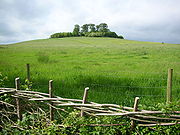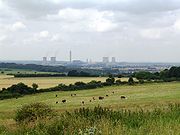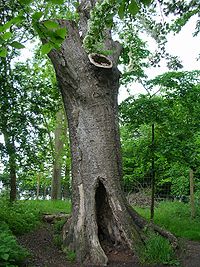
Wittenham Clumps
Encyclopedia

Thames Valley
The Thames Valley Region is a loose term for the English counties and towns roughly following the course of the River Thames as it flows from Oxfordshire in the west to London in the east. It includes parts of Buckinghamshire, Berkshire, North Hampshire, Surrey and west London...
, in the civil parish
Civil parish
In England, a civil parish is a territorial designation and, where they are found, the lowest tier of local government below districts and counties...
of Little Wittenham
Little Wittenham
Little Wittenham is a village and civil parish on the south bank of the River Thames, northeast of Didcot in South Oxfordshire. It has one of only 220 habitats across Europe which is designated as a Special Area of Conservation under the European Union's Habitats Directive , on the Conservation of...
in the English
England
England is a country that is part of the United Kingdom. It shares land borders with Scotland to the north and Wales to the west; the Irish Sea is to the north west, the Celtic Sea to the south west, with the North Sea to the east and the English Channel to the south separating it from continental...
county of Oxfordshire
Oxfordshire
Oxfordshire is a county in the South East region of England, bordering on Warwickshire and Northamptonshire , Buckinghamshire , Berkshire , Wiltshire and Gloucestershire ....
.
They are mostly grassed, but are wooded at the top with ancient Beech
Beech
Beech is a genus of ten species of deciduous trees in the family Fagaceae, native to temperate Europe, Asia and North America.-Habit:...
trees (planted in the 1740s), giving them a distinctive and prominent appearance. However, many of these have died or are dying. The area is a popular beauty spot, with a car park and paths for access by foot. It is maintained as a Nature Reserve
Nature reserve
A nature reserve is a protected area of importance for wildlife, flora, fauna or features of geological or other special interest, which is reserved and managed for conservation and to provide special opportunities for study or research...
by the Northmoor Trust
Northmoor Trust
The Northmoor Trust was set up in 1969 by the British engineer Sir Martin Wood to promote environmental conservation through land management, education and land science...
.
Toponomy


Celtic languages
The Celtic languages are descended from Proto-Celtic, or "Common Celtic"; a branch of the greater Indo-European language family...
, Seno-Dunum, meaning 'Old Fort'. Alternatively, it has been suggested that the name is a scholarly creation, punning on the latin 'sinus' (bosom). Other lesser-used and more colloquial names for the Clumps include the Berkshire Bubs (since the Clumps were formerly in the county of Berkshire - the boundary was redrawn in 1974) and Mother Dunch's Buttocks (after a local Lady of the Manor
Lord of the Manor
The Lordship of a Manor is recognised today in England and Wales as a form of property and one of three elements of a manor that may exist separately or be combined and may be held in moieties...
named Dunch
Edmund Dunch
Edmund Dunch was Master of the Royal Household to Queen Anne and a British Member of Parliament .-Biography:...
). The two main hills are called Castle Hill and Round Hill. A path through the wooded area at the top of Round Hill now enables access since 2005, after being closed for twenty years.
Location
Wittenham Clumps are located at , close to the River ThamesRiver Thames
The River Thames flows through southern England. It is the longest river entirely in England and the second longest in the United Kingdom. While it is best known because its lower reaches flow through central London, the river flows alongside several other towns and cities, including Oxford,...
and good views can be had from the Thames Path
Thames Path
The Thames Path is a National Trail, opened in 1996, following the length of the River Thames from its source near Kemble in Gloucestershire to the Thames Barrier at Charlton. It is about long....
along the river. The panoramic views of the Oxfordshire countryside from the clumps themselves are also spectacular. Day's Lock
Day's Lock
Day's Lock is a lock on the River Thames near Dorchester-on-Thames, Oxfordshire, England on the Dorchester side of the river.The pound lock was built in 1789 by the Thames Navigation Commissioner...
and Dorchester Abbey
Dorchester Abbey
Dorchester Abbey is a Church of England parish church in Dorchester on Thames, Oxfordshire, about southeast of Oxford. It was formerly a Norman abbey church and was built on the site of a Saxon cathedral.-History:...
are clearly visible in the valley to the north. The cooling tower
Cooling tower
Cooling towers are heat removal devices used to transfer process waste heat to the atmosphere. Cooling towers may either use the evaporation of water to remove process heat and cool the working fluid to near the wet-bulb air temperature or in the case of closed circuit dry cooling towers rely...
s of Didcot Power Station
Didcot Power Station
Didcot Power Station refers to a combined coal and oil power plant and a natural-gas power plant that supply the National Grid. They are situated immediately adjoining one another in the civil parish of Sutton Courtenay, next to the town of Didcot in Oxfordshire , in the UK...
dominate the skyline to the west. To the north-east is Little Wittenham Wood, which borders the Thames, and to the south-east is Brightwell Barrow
Brightwell Barrow
Brightwell Barrow is a bronze Age round barrow in the civil parish of Brightwell-cum-Sotwell in the English county of Oxfordshire ....
. The wooded area at the top of Castle Hill, which contains a public footpath, is now closed indefinitely due to the danger of falling trees.
Archaeology
There is a hillfort on Castle Hill. The earliest earthworks date to the late Bronze AgeBronze Age
The Bronze Age is a period characterized by the use of copper and its alloy bronze as the chief hard materials in the manufacture of some implements and weapons. Chronologically, it stands between the Stone Age and Iron Age...
. More banks and ditches were added during the early Iron Age
Iron Age
The Iron Age is the archaeological period generally occurring after the Bronze Age, marked by the prevalent use of iron. The early period of the age is characterized by the widespread use of iron or steel. The adoption of such material coincided with other changes in society, including differing...
. Excavation has revealed that the Iron Age inhabitants caught fish and wild boar
Boar
Wild boar, also wild pig, is a species of the pig genus Sus, part of the biological family Suidae. The species includes many subspecies. It is the wild ancestor of the domestic pig, an animal with which it freely hybridises...
as well as herding cattle and sheep. There is also evidence of farming of barley and wheat. The fort appears to have been abandoned by the late Iron Age, the next occupants being Romans
Roman Britain
Roman Britain was the part of the island of Great Britain controlled by the Roman Empire from AD 43 until ca. AD 410.The Romans referred to the imperial province as Britannia, which eventually comprised all of the island of Great Britain south of the fluid frontier with Caledonia...
. An episode of Channel 4 programme 'Time Team' focused on the clumps in 2004. In 2004 Castle Hill was under excavation by Oxford Archaeology, and the 'Time Team' were charged with investigating the surrounding landscape to see if it they could find any trace of activity that could be associated with the Clumps.
A total of seven hectares was surveyed using ground penetrating radar over the three days. The results highlighted a mass of underlying archaeology, including enclosure ditches, pits, possible buildings and other clusters of anomalies. The geophysics highlighted a large rectilinear enclosure which was subsequently singled out for excavation. This revealed the remains of a Romano-British house with tesserae (mosaic) floors and painted wall plaster. The area also contained an Iron-Age cobbled floor, together with post holes that could have related to a structure.
Further investigations found Iron-Age rubbish pits distributed all over the valley, suggesting widespread settlement throughout the period. Pottery finds indicated that most activity took place in the earlier and later phases of the period, with a quieter occupation phase in the middle. The geophysics surveys also uncovered more suspected Iron-Age enclosures and also what appeared to be a Roman road, which would have been associated with the site.
Poetry

Victorian era
The Victorian era of British history was the period of Queen Victoria's reign from 20 June 1837 until her death on 22 January 1901. It was a long period of peace, prosperity, refined sensibilities and national self-confidence...
'Poem Tree', a beech
Beech
Beech is a genus of ten species of deciduous trees in the family Fagaceae, native to temperate Europe, Asia and North America.-Habit:...
tree with a poem carved into it by Joseph Tubb
Joseph Tubb
Joseph Tubb was a maltster from Oxfordshire, England. His lasting legacy is the Poem Tree at Wittenham Clumps.- Biography :Tubb lived at Lavender Cottage in Warborough, a village near the town of Dorchester. He wished to become a wood carver, but his father convinced him to become a maltster...
of Warborough Green in 1844–45. There is now a stone commemorating the 150th anniversary of the carving.
Wittenham Clumps is said to be where Matthew Prior
Matthew Prior
Matthew Prior was an English poet and diplomat.Prior was the son of a Nonconformist joiner at Wimborne Minster, East Dorset. His father moved to London, and sent him to Westminster School, under Dr. Busby. On his father's death, he left school, and was cared for by his uncle, a vintner in Channel...
wrote Henry and Emma, and this is commemorated by a plaque.
Art and music
Wittenham Clumps were repeatedly painted by the 20th century British artist Paul NashPaul Nash (artist)
Paul Nash was a British landscape painter, surrealist and war artist, as well as a book-illustrator, writer and designer of applied art. He was the older brother of the artist John Nash.-Early life:...
.
The Clumps was the filming location for the Radiohead
Radiohead
Radiohead are an English rock band from Abingdon, Oxfordshire, formed in 1985. The band consists of Thom Yorke , Jonny Greenwood , Ed O'Brien , Colin Greenwood and Phil Selway .Radiohead released their debut single "Creep" in 1992...
webcast video of the band's song "Faust Arp".
External links
- Northmoor Trust
- Little Wittenham at Royal Berkshire History
- Photograph, Geograph British Isles project
- Project Timescape
- Archaeological dig, Time TeamTime TeamTime Team is a British television series which has been aired on Channel 4 since 1994. Created by television producer Tim Taylor and presented by actor Tony Robinson, each episode features a team of specialists carrying out an archaeological dig over a period of three days, with Robinson explaining...
, Channel 4Channel 4Channel 4 is a British public-service television broadcaster which began working on 2 November 1982. Although largely commercially self-funded, it is ultimately publicly owned; originally a subsidiary of the Independent Broadcasting Authority , the station is now owned and operated by the Channel...

